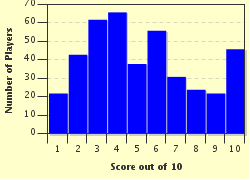Quiz Answer Key and Fun Facts
1. The 'Caesar Cipher' is also known as what?
2. What is special about Rot13?
3. The Vigenère cipher could be described as what?
4. Which of the following is an elegant technique used to break substitution ciphers?
5. What is the effective key size for DES (the Data Encryption Standard)?
6. How many key sizes are standard for AES (the Advanced Encryption Standard)?
7. To generate a pair of RSA (an encryption method named for its inventors: Ron Rivest, Adi Shamir, and Leonard Adleman) keys, what do you need to have?
8. Which of the following is a substitution cipher?
9. Quantum computers are supposed to be able to break advanced systems with large keys, like AES and RSA. Why?
10. If used properly, how secure is a one-time pad?
Source: Author
Hegh
This quiz was reviewed by FunTrivia editor
crisw before going online.
Any errors found in FunTrivia content are routinely corrected through our feedback system.


